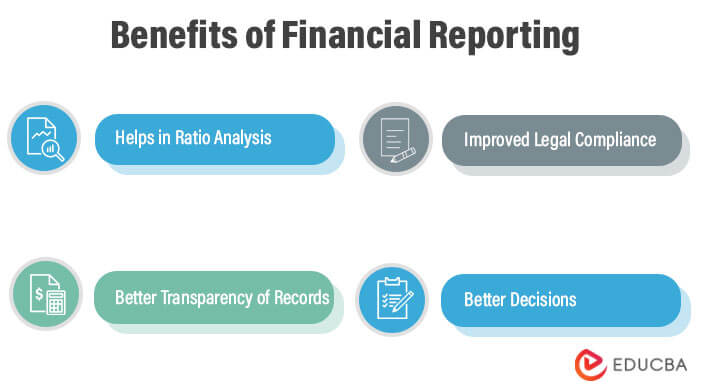Updated July 20, 2023

Introduction to Financial Reporting
Financial Reporting is the reporting of the financial position and results of the organization to the various stakeholders so that they can analyze the safety and security of the investment they made in the organization and it is a very important and critical task for the organization as a single mistake in presentation leads to loss of investors by the organization.
Explanation
Every Function of any business organization is related to the Accounts Department for the presentation of financial statements; the accounts play a vital role. Financial reporting presents the financial position and other details to stakeholders and serves as a public document. Hence it is a work of responsibility, as a single mistake can lead to huge losses. It consists of the following documents: balance sheet, income statement, cash flow statement, equity statement, annual report, director’s report, auditor’s report, etc. It communicates financial-related information to the public and the stakeholders. Moreover, it extends beyond the presentation of financial and other statements. Also, it includes financial communications like litigations to the company, major decisions at a board meeting, management letters and communications, etc.
Objectives of Financial Reporting
Following are the objectives as given below:
- Presentation of Financial Information: The main objective is to communicate the financial and other information to the public and the investors at large so that they can make the correct investment decisions and attract future investors.
- Transparency: The other important objective is to maintain the clarity of the records to prevent any miscommunications and try to present a clear picture before the stakeholders.
- Following Legal Framework: The legal framework also demands presenting the financial statements and being more unambiguous to the public.
- Convery the financial information: Financial reporting goes beyond merely presenting financial statements. The objective is to present all financial-related and important information to the public.
- Presentation of Future Path: Financial reporting aims to attract investors by presenting the future path and actions.
Example of Financial Reporting
ABC Ltd. presented the discussions about the Mergers and acquisitions that will be initiated in the future. Management actively prepares and publishes a report that includes current positions, future actions, and legal formalities for mergers and acquisitions. The detail also includes the cost of the merger and how the organization will manage it. What are the future actions, increment of income after the merger, etc.?
What Includes in Financial Reporting?
It includes the following things:
- Financial Statement: Financial reporting consists of details about the financial statement of the organization and consolidated financial statements, if any.
- Future Actions and Forecasts: Financial Reporting consists of future forecasts and actions that the organization will achieve in the near future.
- Legal Considerations: It also consists of Legal Considerations that are complied with and to be complied with by the organization; the process, cost, and time involved are also included.
- Pending Litigations: It also consists of Pending Litigations with the company, the chances of outcome of the litigations, and the details about the claim involved.
- Pending Tax Issues: It also consists of all pending tax issues and refunds related to the organization, the amount involved, whether disputed or to be paid, etc.
Importance of Financial Reporting
- Better Presentation: It helps to present all the information better. The presentation also includes financial statements and financial-related communications.
- Transparent Records: It gives more transparent records to maintain transparency in the presentation and present a clear picture before the organization.
- Comply with Accounting and Auditing Standards: Financial Reporting is presented in the legal framework; hence, it must comply with applicable reporting framework and accounting and auditing standards.
- Increases Financial Stability and Credit Worthiness: As Financial Reporting Presents transparently, it increases financial stability as the creditors and lenders can analyze the position and security of their funds and improve the organization’s creditworthiness due to proper and transparent presentation.
Benefits of Financial Reporting
Following are the benefits is:
- Helps in Ratio Analysis: It helps in ratio analysis so that the trends can be compared with the industry and measure performance.
- Better Transparency of Records: It helps the organization present better to increase the transparency of records.
- Improved Legal Compliance: It improves legal compliance as the organization can comply with more legal formalities due to public presentations.
- Better Decisions: It helps to make better decisions to safeguard investments.
Limitations of Financial Reporting
Some of the limitations are:
- No Discussions of Non-Financial Data: Non-financial data is not presented and reported in the financial reporting framework. Hence the important non-financial data remains unaffected.
- Comparable Not Presented: The financial reporting presentation presents only the current year’s data. Comparison with the previous year does not reflect; hence it becomes difficult for investors to compare.
- Presented for Specific Time Period: It is presented for the period mentioned instead of from the beginning to the end of the period to make a better clear picture.
Conclusion
It is the presentation of financial information in a legal framework. Apart from the financial position, financial reporting includes financial-related communications to make a clear picture. With better presentations, compliance becomes more due to prevent the remark of non-presentation by the company’s auditors. With proper presentation, it becomes easy for an analyst to analyze the data, compare it with the industry framework, and give advice about investing in a particular company. Financial reporting has major drawbacks in that it presents information for a specific period instead of providing a comprehensive picture and overview from the company’s beginning until the end of the year, which could clarify the overall wealth and performance.
Recommended Articles
This is a guide to Financial Reporting. Here we discuss the definition, objectives, benefits, and limitations. You may also have a look at the following articles to learn more –


